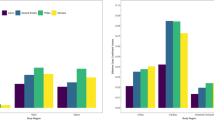Abstract
Most CT dose data aggregation methods do not currently adjust dose values for patient size. This work proposes a simple heuristic for reliably computing an effective diameter of a patient from an abdominal CT image. Evaluation of this method on 106 patients scanned on Philips Brilliance 64 and Brilliance Big Bore scanners demonstrates close correspondence between computed and manually measured patient effective diameters, with a mean absolute error of 1.0 cm (error range +2.2 to −0.4 cm). This level of correspondence was also demonstrated for 60 patients on Siemens, General Electric, and Toshiba scanners. A calculated effective diameter in the middle slice of an abdominal CT study was found to be a close approximation of the mean calculated effective diameter for the study, with a mean absolute error of approximately 1.0 cm (error range +3.5 to −2.2 cm). Furthermore, the mean absolute error for an adjusted mean volume computed tomography dose index (CTDIvol) using a mid-study calculated effective diameter, versus a mean per-slice adjusted CTDIvol based on the calculated effective diameter of each slice, was 0.59 mGy (error range 1.64 to −3.12 mGy). These results are used to calculate approximate normalized dose length product values in an abdominal CT dose database of 12,506 studies.






Similar content being viewed by others
References
Cook TS, Zimmerman S, Maidment AD, Kim W, Boonn WW: Automated extraction of radiation dose information for CT examinations. J Am Coll Radiol 7:871–877, 2010
Li X, Zhang D, Liu B: Automated extraction of radiation dose information from CT dose report images. AJR Am J Roentgenol 196:W781–783, 2011
Morin RL, Coombs LP, Chatfield MB: ACR Dose Index Registry. J Am Coll Radiol 8:288–291, 2011
Cheng PM: Automated PACS retrieval and processing of dose data from legacy CT systems. American Roentgen Ray Society Annual Meeting, 2011
McCollough CH, Leng S, Yu L, Cody DD, Boone JM, McNitt-Gray MF: CT dose index and patient dose: they are not the same thing. Radiology 259:311–316, 2011
American Association of Physicists in Medicine: Size-Specific Dose Estimates (SSDE) in Pediatric and Adult Body CT Examinations: Report of AAPM Task Group 204, College Park, MD, 2011
Kleinman PL, Strauss KJ, Zurakowski D, Buckley KS, Taylor GA: Patient size measured on CT images as a function of age at a tertiary care children’s hospital. AJR Am J Roentgenol 194:1611–1619, 2010
Menke J: Comparison of different body size parameters for individual dose adaptation in body CT of adults. Radiology 236:565–571, 2005
Zarb F, Rainford L, McEntee MF: AP diameter shows the strongest correlation with CTDI and DLP in abdominal and chest CT. Radiat Prot Dosimetry 140:266–273, 2010
Author information
Authors and Affiliations
Corresponding author
Rights and permissions
About this article
Cite this article
Cheng, P.M. Automated Estimation of Abdominal Effective Diameter for Body Size Normalization of CT Dose. J Digit Imaging 26, 406–411 (2013). https://doi.org/10.1007/s10278-012-9525-z
Published:
Issue Date:
DOI: https://doi.org/10.1007/s10278-012-9525-z




